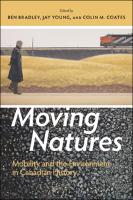Moving Natures
Mobility and Environment in Canadian History
Contributor(s)
Coates, Colin M. (editor)
Bradley, Ben (editor)
Young, Jay (editor)
Language
EnglishAbstract
Mobility - the movements of people, things, and ideas, as well as their associated cultural meanings - has been a key factor in shaping Canadians' perceptions of and interactions with their country. Approaching the burgeoning field of environmental history in Canada through the lens of mobility reveals some of the distinctive ways in which Canadians have come to terms with the country's climate and landscape. Spanning Canada's diverse regions, throughout its history, from the closing of the age of sail to the contemporary era of just-on-time delivery, Moving Natures: Mobility and the Environment in Canadian History examines a wide range of topics, from the impact of seasonal climactic conditions on different transportation modes, to the environmental consequences of building mobility corridors and pathways, to the relationship between changing forms of mobility with tourism and other recreational activities. Contributors make use of traditional archival sources, as well as historical geographic information systems (HGIS), qualitative and quantitative analysis, and critical theory. This thought-provoking collection divides the intersection of environmental and mobility history into two approaches. The chapters in the first section deal primarily with the construction and productive use of mobility technologies and infrastructure, as well as their environmental constraints and consequences. The chapters in the second section focus on consumers' uses of those vehicles and pathways: on pleasure travel, tourism, and recreational mobility. Together, they highlight three quintessentially Canadian themes: seasonality, links between mobility and natural resource development, and urbanites' experiences of the environment through mobility.


 Download
Download